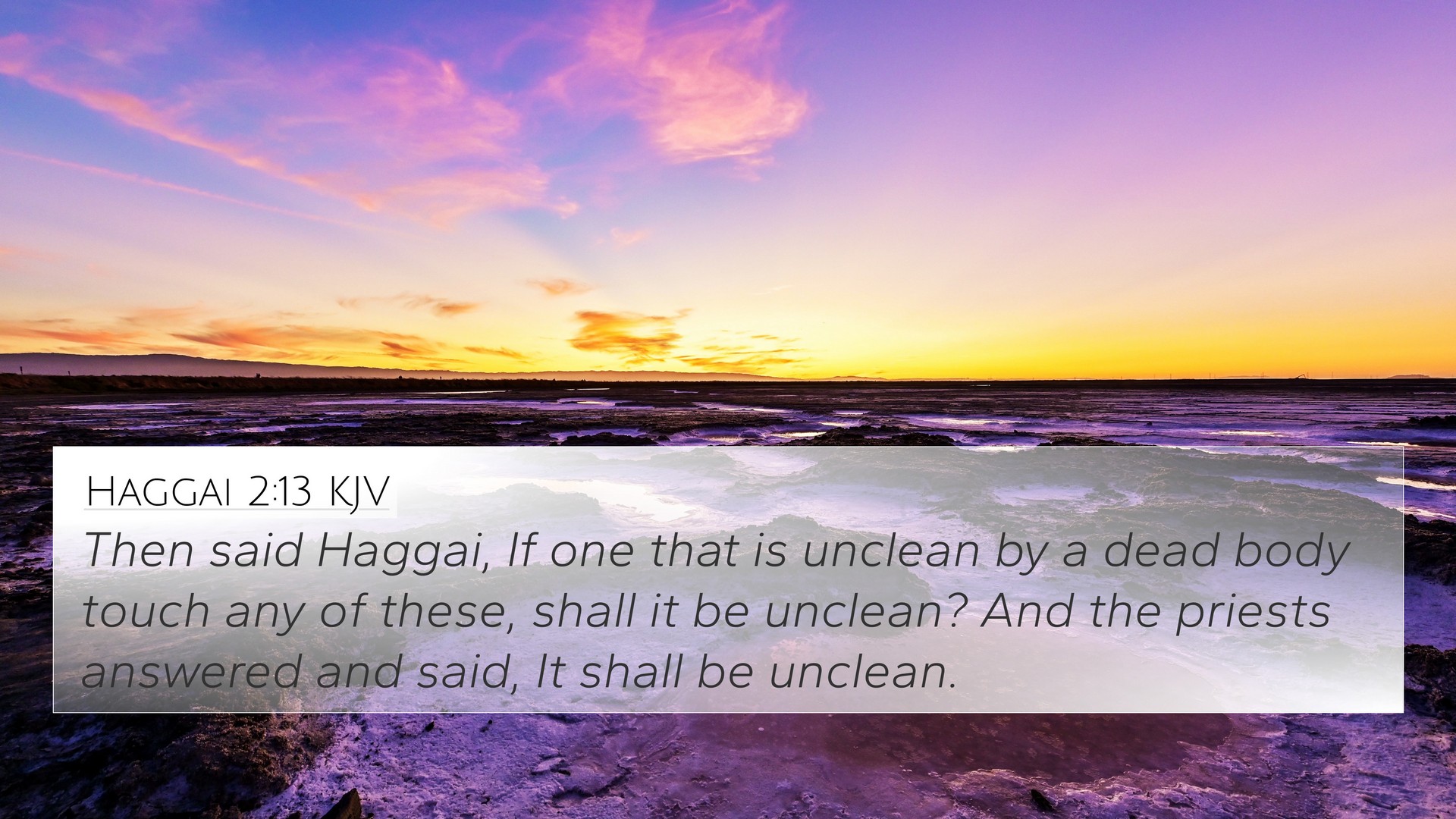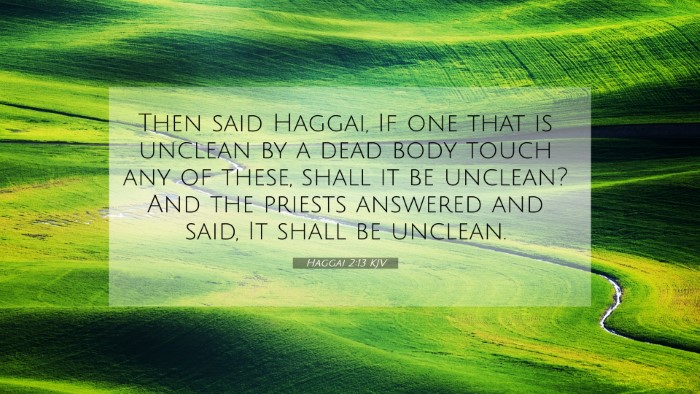Old Testament
Genesis Exodus Leviticus Numbers Deuteronomy Joshua Judges Ruth 1 Samuel 2 Samuel 1 Kings 2 Kings 1 Chronicles 2 Chronicles Ezra Nehemiah Esther Job Psalms Proverbs Ecclesiastes Song of Solomon Isaiah Jeremiah Lamentations Ezekiel Daniel Hosea Joel Amos Obadiah Jonah Micah Nahum Habakkuk Zephaniah Haggai Zechariah MalachiHaggai 2:13 Similar Verses
Haggai 2:13 Cross References
Then said Haggai, If one that is unclean by a dead body touch any of these, shall it be unclean? And the priests answered and said, It shall be unclean.
Uncover the Rich Themes and Topics of This Bible Verse
Listed below are the Bible themes associated with Haggai 2:13. We invite you to explore each theme to gain deeper insights into the Scriptures.
Haggai 2:13 Cross Reference Verses
This section features a detailed cross-reference designed to enrich your understanding of the Scriptures. Below, you will find carefully selected verses that echo the themes and teachings related to Haggai 2:13 KJV. Click on any image to explore detailed analyses of related Bible verses and uncover deeper theological insights.

Leviticus 22:4 (KJV) »
What man soever of the seed of Aaron is a leper, or hath a running issue; he shall not eat of the holy things, until he be clean. And whoso toucheth any thing that is unclean by the dead, or a man whose seed goeth from him;

Numbers 5:2 (KJV) »
Command the children of Israel, that they put out of the camp every leper, and every one that hath an issue, and whosoever is defiled by the dead:

Numbers 9:6 (KJV) »
And there were certain men, who were defiled by the dead body of a man, that they could not keep the passover on that day: and they came before Moses and before Aaron on that day:
Haggai 2:13 Verse Analysis and Similar Verses
Understanding Haggai 2:13
Haggai 2:13 states: "Then said Haggai, If one that is unclean by a dead body touch any of these, shall it be unclean? And the priests answered and said, It shall be unclean." This verse deals with the principles of ceremonial uncleanness and the implications of being spiritually or physically clean according to Levitical law.
Summary of Interpretations
The following commentary insights provide a deeper understanding of this verse:
-
Matthew Henry:
Henry emphasizes the laws regarding uncleanness and purity, which were established for the Israelites to maintain holiness. He illustrates how physical contagion from something unclean reflects spiritual truths, showing that one does not become holy merely by contact with holy things.
-
Albert Barnes:
Barnes notes that Haggai's question reflects the Levite’s understanding of ritual purity. He recognizes that the emphasis is on the transmission of uncleanness rather than the acquisition of holiness, highlighting the corruption that can arise in spiritual practices.
-
Adam Clarke:
Clarke elaborates on the concept of impurity and its broader implications in the context of Israel's return from exile. He underscores the significance of the priestly response, which reaffirms that just as sin can spread, so can the need for purification. Engaging with sacred things does not confer holiness without genuine repentance and cleansing.
Key Themes in Haggai 2:13
This verse introduces several important themes relevant to both historical and contemporary Christian understanding:
- Purity vs. Impurity: The verse examines the tension between being physically/spiritually clean and the consequences of sin.
- Spiritual Contamination: There is an analogy drawn suggesting that proximity to holiness does not impart holiness if not accompanied by genuine faith and repentance.
- Ritual Laws: The customs and laws that governed Israel's worship practices are central, reflecting the importance of obedience to God's covenant.
Bible Verse Cross-References
Haggai 2:13 relates to several biblical texts that deepen its meaning through thematic connections. Here are some significant cross-references:
- Numbers 19:11-22: This passage outlines the laws of touching a dead body and the associated purification rites, essential for understanding the implications of impurity.
- Leviticus 10:10: This verse emphasizes distinguishing between holy and unholy, which connects to the broader theme of maintaining spiritual purity.
- Hebrews 12:14: Pursuing peace and holiness, as mentioned here, reflects the ongoing New Testament teaching regarding purity and sanctification.
- 2 Corinthians 6:17: This call to separate from unclean things draws a parallel to the idea of maintaining a pure worship practice within the community.
- Matthew 15:18-20: Jesus teaches that nothing outside a person can defile them, relating to the inner spiritual condition impacting outward actions.
- James 1:27: Here, James speaks about keeping oneself unspotted from the world, which is vital for understanding personal holiness.
- 1 Peter 1:15-16: This scripture calls believers to be holy as God is holy, reflecting the principles echoing in Haggai's message.
Connections Between Bible Verses
Linking the verses helps illustrate themes central to biblical teaching:
- Examining Leviticus 11:44 in conjunction with Haggai shows consistency in the call for holiness among God's people.
- The motifs in Isaiah 52:11 resonate with the call for holiness and separateness, reinforcing the message of purity.
- In Romans 6:19, the concept of presenting oneself as a slave to righteousness adds depth to the understanding of spiritual cleanliness.
Tools for Bible Cross-Referencing
For deeper exploration, consider using tools designed for Bible cross-referencing:
- Bible Concordance: Handy for locating words and their occurrences to find connections.
- Bible Cross-Reference Guide: Systems designed to highlight intertwined scripture.
- Comprehensive Bible Cross-Reference Materials: Publications that provide verses alongside thematic studies.
Conclusion
Haggai 2:13 serves as a pivotal reminder of the importance of purity—both ritual and spiritual. Through careful examination and cross-referencing with associated scriptures, we see its relevance not only in the context of ancient Israel but also as a guiding principle for contemporary faith practices. The insights gleaned from public domain commentaries enhance our understanding and provide context, allowing for a richer appreciation of the text.



